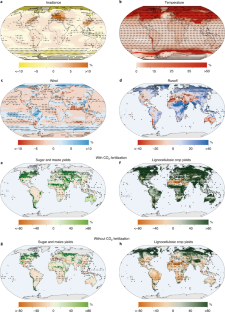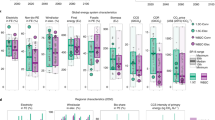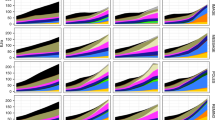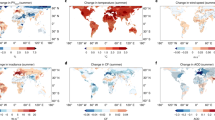Abstract
Renewable energy resources, which depend on climate, may be susceptible to future climate change. Here we use climate and integrated assessment models to estimate this effect on key renewables. Future potential and costs are quantified across two warming scenarios for eight technologies: utility-scale and rooftop photovoltaic, concentrated solar power, onshore and offshore wind energy, first-generation and lignocellulosic bioenergy, and hydropower. The generated cost–supply curves are then used to estimate energy system impacts. In a baseline warming scenario, the largest impact is increased availability of bioenergy, though this depends on the strength of CO2 fertilization. Impacts on hydropower and wind energy are uncertain, with declines in some regions and increases in others, and impacts on solar power are minor. In a future mitigation scenario, these impacts are smaller, but the energy system response is similar to that in the baseline scenario given a larger reliance of the mitigation scenario on renewables.
This is a preview of subscription content, access via your institution
Access options
Access Nature and 54 other Nature Portfolio journals
Get Nature+, our best-value online-access subscription
$29.99 / 30 days
cancel any time
Subscribe to this journal
Receive 12 print issues and online access
$209.00 per year
only $17.42 per issue
Buy this article
- Purchase on Springer Link
- Instant access to full article PDF
Prices may be subject to local taxes which are calculated during checkout




Similar content being viewed by others
Data availability
Source data are provided with this paper.
Code availability
The code that produced the renewable energy potentials and cost curves can be found at https://github.com/davidgernaat. PBL holds the proprietary rights to the IMAGE computer code; extensive documentation is provided (https://models.pbl.nl/image).
Change history
19 February 2021
A Correction to this paper has been published: https://doi.org/10.1038/s41558-021-01005-w
References
IEA. World Energy Outlook (International Energy Agency, 2017).
Ram, M., et al. Global Energy System based on 100% Renewable Energy – Power, Heat, Transport and Desalination Sectors (Lappeenranta University of Technology and Energy Watch Group, 2019).
Jacobson, M. Z., Delucchi, M. A., Cameron, M. A. & Mathiesen, B. V. J. R. E. Matching demand with supply at low cost in 139 countries among 20 world regions with 100% intermittent wind, water, and sunlight (WWS) for all purposes. Renew. Energy 123, 236–248 (2018).
Teske, S. Achieving the Paris Climate Agreement Goals (Springer, 2019).
Bogdanov, D. et al. Radical transformation pathway towards sustainable electricity via evolutionary steps. Nat. Commun. 10, 1077 (2019).
Hansen, K., Breyer, C. & Lund, H. J. E. Status and perspectives on 100% renewable energy systems. Energy 175, 471–480 (2019).
Turner, S. W. D., Hejazi, M., Kim, S. H., Clarke, L. & Edmonds, J. Climate impacts on hydropower and consequences for global electricity supply investment needs. Energy 141, 2081–2090 (2017).
van Vliet, M. T. H., Wiberg, D., Leduc, S. & Riahi, K. Power-generation system vulnerability and adaptation to changes in climate and water resources. Nat. Clim. Change 6, 375–380 (2016).
Gernaat, D. E. H. J., Bogaart, P. W., van Vuuren, D. P., Biemans, H. & Niessink, R. High-resolution assessment of global technical and economic hydropower potential. Nat. Energy 2, 821–828 (2017).
Schaeffer, R. et al. Energy sector vulnerability to climate change: a review. Energy 38, 1–12 (2012).
Mideksa, T. K. & Kallbekken, S. The impact of climate change on the electricity market: a review. Energy Policy 38, 3579–3585 (2010).
Ciscar, J.-C. & Dowling, P. Integrated assessment of climate impacts and adaptation in the energy sector. Energy Econ. 46, 531–538 (2014).
Chandramowli, S. N. & Felder, F. A. Impact of climate change on electricity systems and markets—a review of models and forecasts. Sustain. Energy Technol. Assess. 5, 62–74 (2014).
Pryor, S. C. & Barthelmie, R. J. Climate change impacts on wind energy: a review. Renew. Sustain. Energy Rev. 14, 430–437 (2010).
CCSP. Effects of Climate Change on Energy Production and Use in the United States – Synthesis and Assessment Product 4.5 (US Climate Change Program, 2008).
Li, D. H. W., Yang, L. & Lam, J. C. Impact of climate change on energy use in the built environment in different climate zones—a review. Energy 42, 103–112 (2012).
Emodi, N. V., Chaiechi, T. & Rabiul Alam Beg, A. The impact of climate variability and change on the energy system: A systematic scoping review. Sci. Total Environ. 676, 545–563 (2019).
Yalew, S. G. et al. Impacts of climate change on energy systems in global and regional scenarios. Nat. Energy 5, 794–802 (2020).
Hoogwijk, M. M. On the global and regional potential of renewable energy sources (Faculteit Scheikunde, Universiteit Utrecht, 2004).
Köberle, A. C., Gernaat, D. E. H. J. & van Vuuren, D. P. Assessing current and future techno-economic potential of concentrated solar power and photovoltaic electricity generation. Energy 89, 739–756 (2015).
Gernaat, D. E., de Boer, H.-S., Dammeier, L. C. & van Vuuren, D. P. The role of residential rooftop photovoltaic in long-term energy and climate scenarios. Appl. Energy 279, 115705 (2020).
Daioglou, V., Doelman, J. C., Wicke, B., Faaij, A. & van Vuuren, D. P. Integrated assessment of biomass supply and demand in climate change mitigation scenarios. Glob. Environ. Change 54, 88–101 (2019).
Warszawski, L. et al. The inter-sectoral impact model intercomparison project (ISI–MIP): project framework. Proc. Natl Acad. Sci. USA 111, 3228–3232 (2014).
Jerez, S. et al. The impact of climate change on photovoltaic power generation in Europe. Nat. Commun. 6, 10014 (2015).
Crook, J. A., Jones, L. A., Forster, P. M. & Crook, R. Climate change impacts on future photovoltaic and concentrated solar power energy output. Energy Environ. Sci. 4, 3101–3109 (2011).
ORNL. New Stream-reach Development: A Comprehensive Assessment of Hydropower Energy Potential in the United States (Oak Ridge National Laboratory, 2014).
Haberl, H. et al. Global bioenergy potentials from agricultural land in 2050: sensitivity to climate change, diets and yields. Biomass Bioenergy 35, 4753–4769 (2011).
IAMC documentation contributors. IAMC wiki http://iamcdocumentation.eu/ (2018).
van Vuuren, D. P. et al. Energy, land-use and greenhouse gas emissions trajectories under a green growth paradigm. Glob. Environ. Change 42, 237–250 (2017).
Doelman, J. C. et al. Exploring SSP land-use dynamics using the IMAGE model: regional and gridded scenarios of land-use change and land-based climate change mitigation. Glob. Environ. Change 48, 119–135 (2018).
van Vuuren, D. P. et al. Alternative pathways to the 1.5 °C target reduce the need for negative emission technologies. Nat. Clim. Change 8, 391–397 (2018).
Field, C. B., Barros, V., Stocker, T. F. & Dahe, Q. Managing the Risks of Extreme Events and Disasters to Advance Climate Change Adaptation: Special Report of the Intergovernmental Panel on Climate Change (Cambridge Univ. Press, 2012).
IPCC Climate Change 2014: Impacts, Adaptation, and Vulnerability (eds Field, C. B. et al.) (Cambridge Univ. Press, 2014).
Gerten, D., Schaphoff, S., Haberlandt, U., Lucht, W. & Sitch, S. Terrestrial vegetation and water balance—hydrological evaluation of a dynamic global vegetation model. J. Hydrol. 286, 249–270 (2004).
Bondeau, A. et al. Modelling the role of agriculture for the 20th century global terrestrial carbon balance. Glob. Change Biol. 13, 679–706 (2007).
Beringer, T., Lucht, W. & Schaphoff, S. Bioenergy production potential of global biomass plantations under environmental and agricultural constraints. GCB Bioenergy 3, 299–312 (2011).
Gernaat, D. Scripts used to generate results presented herein github.com/davidgernaat/Solar_CostCurves Version v1.0.0 (Zenodo, 2020); https://doi.org/10.5281/zenodo.4059441
Gernaat, D. E. H. J., van Vuuren, D. P., van Vliet, J., Sullivan, P. & Arent, D. J. Global long-term cost dynamics of offshore wind electricity generation. Energy 76, 663–672 (2014).
Gernaat, D. Scripts used to generate results presented herein github.com/davidgernaat/Wind_CostCurves Version v1.0.0 (Zenodo, 2020); https://doi.org/10.5281/zenodo.4059451
Daioglou, V. & Gernaat, D. E. Scripts used to generate results presented herein github.com/davidgernaat/Bio_CostCurves Version v1.0.0 (Zenodo, 2020); https://doi.org/10.5281/zenodo.4059455
Gernaat, D. Scripts used to generate results presented herein github.com/davidgernaat/Hydro_CostCurves Version v1.0.1 (Zenodo, 2020); https://doi.org/10.5281/zenodo.4059487
Gernaat, D. Scripts used to generate results presented herein github.com/davidgernaat/Hydro_ClimateImpacts Version v1.0.0 (Zenodo, 2020); https://doi.org/10.5281/zenodo.4059453
Fraunhofer Institute. Photovoltaics Report (Fraunhofer Institute for Solar Energy Systems, 2018).
IRENA. Renewable Power Generation Costs in 2017 (International Renewable Energy Agency, 2018).
Daioglou, V., van Ruijven, B. J. & van Vuuren, D. P. Model projections for household energy use in developing countries. Energy 37, 601–615 (2012).
Gagnon, P., Margolis, R., Melius, J., Phillips, C. & Elmore, R. Rooftop Solar Photovoltaic Technical Potential in the United States: A Detailed Assessment (National Renewable Energy Laboratory, 2016).
Radziemska, E. The effect of temperature on the power drop in crystalline silicon solar cells. Renew. Energy 28, 1–12 (2003).
Tonui, J. K. & Tripanagnostopoulos, Y. Performance improvement of PV/T solar collectors with natural air flow operation. Sol. Energy 82, 1–12 (2008).
Dudley, V. Test Results for Industrial Solar Technology Parabolic Trough Solar Collector (Sandia National Laboratory, 1995).
van Vuuren, D. P. Energy Systems and Climate Policy—Long-Term Scenarios for an Uncertain Future (Utrecht University, 2007).
IEA. World Energy Outlook (International Energy Agency, 2019).
IRENA. Renewable Capacity Statistics (International Renewable Energy Agency, 2019).
Acknowledgements
A. Righart is acknowledged for editing part of the manuscript. The research leading to these results has received funding from EU’s Horizon 2020 Navigate (no. 821124). We thank the JPI Climate initiative and participating grant institutes for funding the ISIpedia project.
Author information
Authors and Affiliations
Contributions
D.E.H.J.G. and D.P.v.V. developed the idea. D.E.H.J.G. designed the experiments and wrote the manuscript. S.G.Y. managed all climate input data. C.M. conducted model simulations and provided bioenergy yield data. V.D. calculated the bioenergy potential. All authors discussed the results and contributed to the manuscript.
Corresponding author
Ethics declarations
Competing interests
The authors declare no competing interests.
Additional information
Peer review information Nature Climate Change thanks Andre Lucena, Hannes Weigt and the other, anonymous, reviewer(s) for their contribution to the peer review of this work.
Publisher’s note Springer Nature remains neutral with regard to jurisdictional claims in published maps and institutional affiliations.
Extended data
Extended Data Fig. 1 GCM model mean for historical 30-year (1970–2000) average climate data used as input to calculate energy potentials.
a, Solar irradiance (kWh m−2 day−1) (global horizontal). b, Temperature (°C). c, Wind speeds (m s−1). d, Runoff (kg m−2 s−1). e, Sugar cane and maize yields (crop selected with highest yield per cell) (%). f, Lignocellulosic crop yields (switchgrass and Miscanthus, or trees) (crop selected with highest yield per cell) (%).
Extended Data Fig. 2 GCM model mean change of climate patterns and yields in RCP2.6.
a, solar irradiance (%) (global horizontal). b, temperature (%). (%). c, Wind speed (%). d, Runoff (%). e, Sugar cane and maize yields with CO2 fertilisation (crop selected with highest yield per cell) (%). f, Lignocellulosic crop yields (switchgrass and Miscanthus, or trees) with CO2 fertilisation (crop selected with highest yield per cell) (%).
Extended Data Fig. 3 Schematic illustration showing how climatic parameters can change the design discharge and load factors of a hydropower system.
a, The purple line shows a typical historical discharge pattern at a hydropower location with a wet and dry season. The yellow line shows how new climate-change-induced precipitation patterns influence the discharge pattern, in this case with a wetter wet season and a prolonged dry season. Ordering the yellow line data into a flow duration curve, as illustrated in b, changes the design flow and design load factors. b, The flow duration curve with the new discharge pattern. The new discharge pattern (yellow line in a) forms a new flow duration curve with new design flow (defined as the fourth highest discharge month) and new design load factor (note that the months have shifted, too). The grey lines represent the old climate, the black lines illustrate the new.
Extended Data Fig. 4 Multi-model mean change of technical potential in RCP2.6.
a, Utility-scale PV and rooftop PV. b, Concentrated Solar Power (CSP). c, Onshore and offshore wind energy. d, Hydropower. e, First-generation bioenergy with CO2 fertilisation. f, Lignocellulosic bioenergy with CO2 fertilisation.
Extended Data Fig. 5 The global mean changes in technical potential per renewable technology under RCP2.6.
a, Absolute change in technical potential compared to the historical situation (EJ y−1). b, Relative change in technical potential compared to the historical situation (%).
Extended Data Fig. 6 Shared Socioeconomic Pathways (SSPs) assumptions for IMAGE.
a, Global population (million) for SSP1-3. b, Economic development for SSP1-3 (GDP trillion USD2005 y−1). c, Global final energy demand per sector for SSP1-3. d, Global primary energy use per energy carrier for SSP2 and SSP2-RCP26.
Extended Data Fig. 7 The direct and indirect effect of climate impacts on cumulative primary energy in SSP2-RCP60-CI without CO2 fertilisation (2070–2100).
The top row shows the combined (a), direct (b) and indirect (c) mean change between a run with and without climate impacts on renewables in cumulative energy production (2070–2100) per technology group (%). The bottom row shows the uncertainty using the combined (d), direct (e) and indirect (f) absolute and relative standard deviation of the data shown in the top row.
Extended Data Fig. 8 The direct and indirect effect of climate impacts on cumulative primary energy in SSP2-RCP60-CI with CO2 fertilisation (2070–2100).
The top row shows the combined (a), direct (b) and indirect (c) mean change between a run with and without climate impacts climate impact in cumulative energy production (2070–2100) per technology group (%). The bottom row shows the uncertainty using the combined (d), direct (e) and indirect (f) absolute and relative standard deviation of the data shown in the top row.
Extended Data Fig. 9 The combined relative effect of SSP2-RCP60-HRES climate impacts on cumulative primary energy supply per IMAGE model region.
a, The mean change (over the GCMs) of the cumulative primary energy supply in the period 2070–2100 per technology. b, The absolute (shown in orange gradient) and relative (shown in grey dot size) standard deviation of the data shown in a.
Extended Data Fig. 10 The combined relative effect of SSP2-RCP26 climate impacts on cumulative primary energy supply per IMAGE model region.
a, The mean change (over the GCMs) of the cumulative primary energy supply in the period 2070–2100 per technology. b, The absolute (shown in orange gradient) and relative (shown in grey dot size) standard deviation of the data shown in a.
Supplementary information
Supplementary Information
Supplementary Texts 1–3, Tables 1–5 and Figs. 1–12.
Source data
Source Data Fig. 1
Model mean (GFLD-ESM2M, HadGEM2-ES, IPSL-CM5A-LR and MIROC5) historical (1970–2000), RCP2.6 (2070–2100) and RCP6.0 (2070–2100) climate input data: Solar irradiance (kWh m−2 per day) (global horizontal), temperature (°C), wind speed (m s−1), runoff (kg m−2 s−1), sugar cane and maize yields (t ha−1 yr−1) and lignocellulosic crop yields (switchgrass and Miscanthus, or trees) (t ha−1 yr−1).
Source Data Fig. 2
Technical potential per GCM for the historical (1970–2000) period, and the future RCP2.6 (2070–2100) and RCP6.0 (2070–2100) periods: utility-scale PV and rooftop PV, concentrated solar power (CSP), pnshore and offshore wind energy, hydropower, first-generation bioenergy, and lignocellulosic bioenergy with and without CO2 fertilization.
Source Data Fig. 3
Technical potential per region, GCM and RCP for: utility-scale PV and rooftop PV, concentrated solar power (CSP), onshore and offshore wind energy, hydropower, first-generation bioenergy, and lignocellulosic bioenergy with and without CO2 fertilization.
Source Data Fig. 4
Primary energy supply (2071–2100) based on historical, RCP2.6 and RCP6.0 climate with and without CO2 fertilization (PJ).
Source Data Extended Data Fig. 1
Model mean (GFLD-ESM2M, HadGEM2-ES, IPSL-CM5A-LR and MIROC5) historical (1970–2000), RCP2.6 (2070–2100) and RCP6.0 (2070–2100) climate input data: solar irradiance (kWh m−2 per day) (global horizontal), temperature (°C), wind speed (m s−1), runoff (kg m−2 s−1), sugar cane and maize yields (t ha−1 yr−1) and lignocellulosic crop yields (switchgrass and Miscanthus, or trees) (t ha−1 yr−1).
Source Data Extended Data Fig. 2
Model mean (GFLD-ESM2M, HadGEM2-ES, IPSL-CM5A-LR and MIROC5) historical (1970–2000), RCP2.6 (2070–2100) and RCP6.0 (2070–2100) climate input data: solar irradiance (kWh m−2 per day) (global horizontal), temperature (°C), wind speed (m s−1), runoff (kg m−2 s−1), sugar cane and maize yields (t ha−1 yr−1) and lignocellulosic crop yields (switchgrass and Miscanthus, or trees) (t ha−1 yr−1).
Source Data Extended Data Fig. 4
Technical potential per GCM for the historical (1970–2000) period, and the future RCP2.6 (2070–2100) and RCP6.0 (2070–2100) periods: utility-scale PV and rooftop PV, concentrated solar power (CSP), pnshore and offshore wind energy, hydropower, first-generation bioenergy, and lignocellulosic bioenergy with and without CO2 fertilization.
Source Data Extended Data Fig. 5
Technical potential per region, GCM and RCP for: utility-scale PV and rooftop PV, concentrated solar power (CSP), onshore and offshore wind energy, hydropower, first-generation bioenergy, and lignocellulosic bioenergy with and without CO2 fertilization.
Source Data Extended Data Fig. 7
Primary energy supply (2071–2100) based on historical, RCP2.6 and RCP6.0 climate with and without CO2 fertilization (PJ).
Source Data Extended Data Fig. 8
Primary energy supply (2071–2100) based on historical, RCP2.6 and RCP6.0 climate with and without CO2 fertilization (PJ).
Source Data Extended Data Fig. 9
Primary energy supply (2071–2100) based on historical, RCP2.6 and RCP6.0 climate with and without CO2 fertilization (PJ).
Source Data Extended Data Fig. 10
Primary energy supply (2071–2100) based on historical, RCP2.6 and RCP6.0 climate with and without CO2 fertilization (PJ).
Rights and permissions
About this article
Cite this article
Gernaat, D.E.H.J., de Boer, H.S., Daioglou, V. et al. Climate change impacts on renewable energy supply. Nat. Clim. Chang. 11, 119–125 (2021). https://doi.org/10.1038/s41558-020-00949-9
Received:
Accepted:
Published:
Issue Date:
DOI: https://doi.org/10.1038/s41558-020-00949-9
This article is cited by
-
Maximizing solar power generation through conventional and digital MPPT techniques: a comparative analysis
Scientific Reports (2024)
-
Spatiotemporal management of solar, wind and hydropower across continental Europe
Communications Engineering (2024)
-
Climate change will impact the value and optimal adoption of residential rooftop solar
Nature Climate Change (2024)
-
Hydropower expansion in eco-sensitive river basins under global energy-economic change
Nature Sustainability (2024)
-
Tailoring the surface and interface structures of photocatalysts to enhance hydrogen production
Science China Chemistry (2024)



